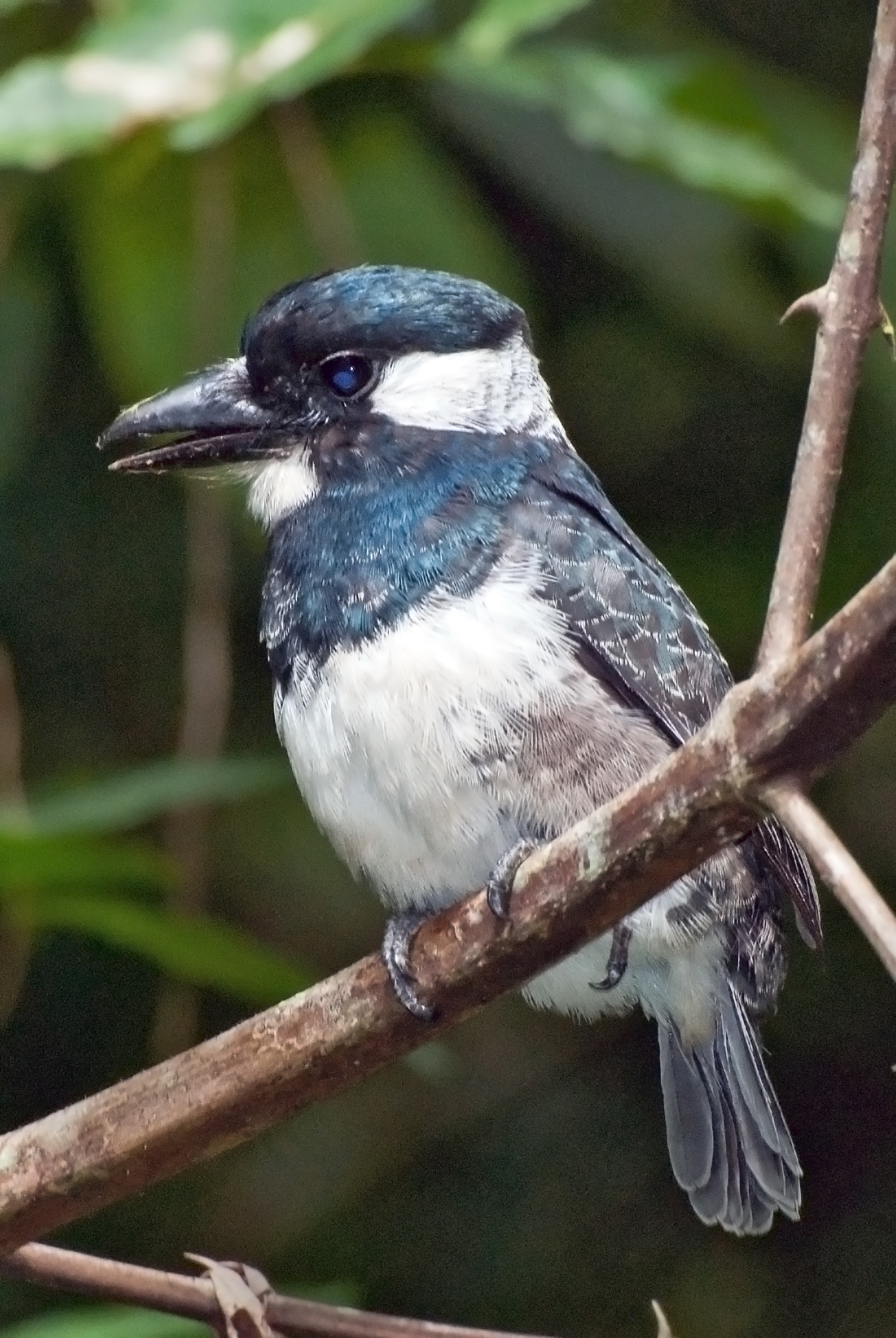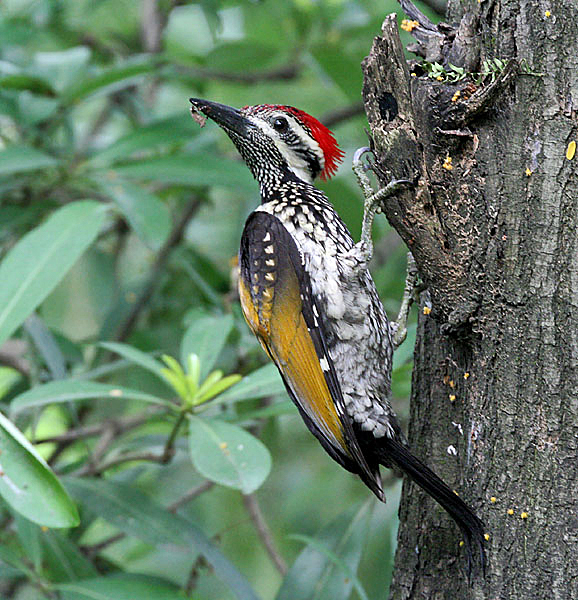|
Megalaimidae
Megalaimidae, the Asian barbets, are a family of birds, comprising two genera with 35 species native to the forests of the Indomalayan realm from Tibet to Indonesia. They were once clubbed with all barbets in the family Capitonidae but the Old World species have been found to be distinctive and are considered, along with the Lybiidae and Ramphastidae, as sister groups. Taxonomy In the past the species were placed in three genera, ''Caloramphus'', ''Megalaima'' and ''Psilopogon'', but studies show that ''Psilopogon'' to be nested within the clade of ''Megalaima''. Since members of this clade are better treated under a single genus, they have been moved to the genus ''Psilopogon'' which was described and erected earlier than ''Megalaima'' and is therefore chosen on the basis of taxonomic priority principles. Nearly all members of the family are now in the genus ''Psilopogon'', with the exception of those in ''Caloramphus'', which are thought to have Genetic divergence, genetically d ... [...More Info...] [...Related Items...] OR: [Wikipedia] [Google] [Baidu] |
Piciformes
Nine families of largely arboreal birds make up the order Piciformes (), the best-known of them being the Picidae, which includes the woodpeckers and close relatives. The Piciformes contain about 71 living genera with a little over 450 species, of which the Picidae make up about half. In general, the Piciformes are insectivorous, although the barbets and toucans mostly eat fruit and the honeyguides are unique among birds in being able to digest beeswax (although insects make up the bulk of their diet). Nearly all Piciformes have parrot-like zygodactyl feet—two toes forward and two back, an arrangement that has obvious advantages for birds that spend much of their time on tree trunks. An exception are a few species of three-toed woodpeckers. The jacamars aside, Piciformes do not have down feathers at any age, only true feathers. They range in size from the rufous piculet at 8 centimetres in length, and weighing 7 grams, to the toco toucan, at 63 centimetres long, and ... [...More Info...] [...Related Items...] OR: [Wikipedia] [Google] [Baidu] |
Lybiidae
Lybiidae is a family (biology), family of birds also known as the African barbets. There are 44 species ranging from the type genus ''Lybius'' of forest interior to the tinkerbirds (''Pogoniulus'') of forest and scrubland. They are found throughout sub-Saharan Africa, with the exception of the far south-west of South Africa. The African terrestrial barbets, Trachyphoninae, range from the southern Sahara to South Africa. Members of one genus, ''Trachyphonus'', are the most open-country species of barbets. The subfamily Lybiinae contains the African arboreal barbets. There are 37 species of Lybiinae in 6 genera. Taxonomy The Phylogenetics, phylogenetic relationship between the African barbets and the eight other families in the Order (biology), order Piciformes is shown in the cladogram below. The number of species in each family is taken from the list maintained by Frank Gill (ornithologist), Frank Gill, Pamela C. Rasmussen and David Donsker on behalf of the International Ornithol ... [...More Info...] [...Related Items...] OR: [Wikipedia] [Google] [Baidu] |
Capitonidae
The New World barbets are a family, Capitonidae, of 15 birds in the order Piciformes, which inhabit humid forests in Central and South America. They are closely related to the toucans. The New World barbets are plump birds, with short necks and large heads. They get their name from the bristles that fringe their heavy bills. Most species are brightly coloured and live in tropical forest. These barbets are mostly arboreal birds, which nest in tree holes dug by breeding pairs, laying two to four eggs. They eat fruit and insects. These birds do not bird migration, migrate. Taxonomy Fossil New World barbets have been found dating from the Miocene in Florida. The closest relatives of the barbets are the toucans, and these two families are also closely related to the honeyguides and woodpeckers (with which they form the order (biology), order Piciformes). Formerly, the barbets have been treated as one family Family (from ) is a Social group, group of people related either by ... [...More Info...] [...Related Items...] OR: [Wikipedia] [Google] [Baidu] |
Flame-fronted Barbet
The flame-fronted barbet (''Psilopogon armillaris'') is an Asian barbet native to Java and Bali. It has a green plumage, a yellow-orange forehead, a blue nape, and an orange crescent on the chest. It is about long and weighs . Its natural habitats are subtropical or tropical moist lowland forest and subtropical or tropical moist montane forest Montane ecosystems are found on the slopes of mountains. The alpine climate in these regions strongly affects the ecosystem because temperatures lapse rate, fall as elevation increases, causing the ecosystem to stratify. This stratification is .... References External links *https://www.hbw.com/species/flame-fronted-barbet-psilopogon-armillaris flame-fronted barbet Birds of Java Birds of Bali Endemic birds of Indonesia flame-fronted barbet Taxonomy articles created by Polbot {{Piciformes-stub ... [...More Info...] [...Related Items...] OR: [Wikipedia] [Google] [Baidu] |
Blue-throated Barbet
The blue-throated barbet (''Psilopogon asiaticus'') is a green Megalaimidae, Asian barbet native to the foothills of the Himalayas and Southeast Asia. It inhabits lowland and montane forests at elevations of , frequenting fruiting trees. Due to its green colour, it is difficult to spot but is easily located by its continual loud calls. Sexes are similar in most respects and share domestic duties. Taxonomy The Blue-throated Barbet was originally placed in the genus ''Cyanops'' by Latham in 1790. This was subsequently synonymized with ''Psilopogon, Megalaima''. In 2013, Phylogenetics, phylogenetic studies indicated that ''Psilopogon'' is embedded within ''Megalaima''. ''Psilopogon'' has priority, hence the genus ''Megalaima'' was subsumed into ''Psilopogon''. The Blue-throated Barbet has previously been considered Biological specificity, conspecific with the Turquoise-throated barbet, Turquoise-throated Barbet (''Psilopogon chersonesus'') and the Mountain barbet, Mountain ... [...More Info...] [...Related Items...] OR: [Wikipedia] [Google] [Baidu] |
Galbulidae
The jacamars are a family, Galbulidae, of birds from tropical South and Central America, extending up to Mexico. The family contains five genera and 18 species. The family is closely related to the puffbirds, another Neotropical The Neotropical realm is one of the eight biogeographic realms constituting Earth's land surface. Physically, it includes the tropical terrestrial ecoregions of the Americas and the entire South American temperate zone. Definition In biogeogra ... family, and the two families are often separated into their own order, Galbuliformes, separate from the Piciformes. They are principally birds of low-altitude woodlands and forests, and particularly of forest edge and forest canopy, canopy. Taxonomy The placement of the combined puffbird and jacamar lineage was in question, with some bone and muscle features suggesting they may be more closely related to the Coraciiformes. However, analysis of nuclear DNA in a 2003 study placed them as sister group to th ... [...More Info...] [...Related Items...] OR: [Wikipedia] [Google] [Baidu] |
Ramphastidae
Toucans (, ) are Neotropical birds in the family Ramphastidae. They are most closely related to the Toucan barbets. They are brightly marked and have large, often colorful bills. The family includes five genera and over 40 different species. Toucans are arboreal and typically lay two to four white eggs in their nests. They make their nests in tree hollows and holes excavated by other animals such as woodpeckers—the toucan bill has very limited use as an excavation tool. When the eggs hatch, the young emerge completely naked, without any down. Toucans are resident breeders and do not migrate. Toucans are usually found in pairs or small flocks. They sometimes fence with their bills and wrestle, which scientists hypothesize they do to establish dominance hierarchies. In Africa and Asia, hornbills occupy the toucans' ecological niche, an example of convergent evolution. Taxonomy and systematics The name of this bird group is derived from the Tupi word ''tukana'' or the G ... [...More Info...] [...Related Items...] OR: [Wikipedia] [Google] [Baidu] |
Bucconidae
The puffbirds and their relatives in the family Bucconidae are tropical tree-dwelling insectivorous birds that are found from South America up to Mexico. Together with their closest relatives, the jacamars, they form a divergent lineage within the order Piciformes, though the two families are sometimes elevated to a separate order Galbuliformes. Lacking the iridescent colours of the jacamars, puffbirds are mainly brown, rufous or grey, with large heads, large eyes, and flattened bills with a hooked tip. Their loose, abundant plumage and short tails makes them look stout and puffy, giving rise to the English name of the family. The species range in size from the rufous-capped nunlet, at and , to the white-necked puffbird, at up to and . Taxonomy Puffbirds get their common name from their fluffy plumage. In Spanish, they have been nicknamed ''bobo'' ("dummy") from their propensity to sit motionless waiting for prey. American naturalist Thomas Horsfield defined the Bucconidae in ... [...More Info...] [...Related Items...] OR: [Wikipedia] [Google] [Baidu] |
Indicatoridae
Honeyguides (family Indicatoridae) are a family of birds in the order Piciformes. They are also known as indicator birds, or honey birds, although the latter term is also used more narrowly to refer to species of the genus '' Prodotiscus''. They have an Old World tropical distribution, with the greatest number of species in Africa and two in Asia. These birds are best known for their interaction with humans. Honeyguides are noted and named for one or two species that will deliberately lead humans directly to bee colonies, so that they can feast on the grubs and beeswax that are left behind. Localized interaction between honeyguides and honey badgers has been reported. Taxonomy The Indicatoridae were noted for their barbet-like structure and brood-parasitic behavior and morphologically considered unique among the non-passerines in having nine primaries. The phylogenetic relationship between the honeyguides and the eight other families that make up the order Piciformes is shown in ... [...More Info...] [...Related Items...] OR: [Wikipedia] [Google] [Baidu] |
Indomalayan Realm
The Indomalayan realm is one of the eight biogeographic realms. It extends across most of South and Southeast Asia and into the southern parts of East Asia. Also called the Oriental realm by biogeographers, Indomalaya spreads all over the Indian subcontinent and Southeast Asia to lowland southern China, and through Indonesia as far as Sumatra, Java, Bali, and Borneo, east of which lies the Wallace line, the realm boundary named after Alfred Russel Wallace which separates Indomalaya from Australasia. Indomalaya also includes the Philippines, lowland Taiwan, and Japan's Ryukyu Islands. Most of Indomalaya was originally covered by forest, and includes tropical and subtropical moist broadleaf forests, with tropical and subtropical dry broadleaf forests predominant in much of India and parts of Southeast Asia. The tropical forests of Indomalaya are highly variable and diverse, with economically important trees, especially in the families Dipterocarpaceae and Fabaceae. Major ecol ... [...More Info...] [...Related Items...] OR: [Wikipedia] [Google] [Baidu] |
Picidae
Woodpeckers are part of the bird family Picidae, which also includes the piculets, wrynecks and sapsuckers. Members of this family are found worldwide, except for Australia, New Guinea, New Zealand, Madagascar and the extreme polar regions. Most species live in forests or woodland habitats, although a few species are known that live in treeless areas, such as rocky hillsides and deserts, and the Gila woodpecker specializes in exploiting cacti. Members of this family are chiefly known for their characteristic behaviour. They mostly forage for insect prey on the trunks and branches of trees, and often communicate by drumming with their beaks, producing a reverberatory sound that can be heard at some distance. Some species vary their diet with fruits, birds' eggs, small animals, tree sap, human scraps, and carrion. They usually nest and roost in holes that they excavate in tree trunks, and their abandoned holes are of importance to other cavity-nesting birds. They sometimes com ... [...More Info...] [...Related Items...] OR: [Wikipedia] [Google] [Baidu] |




